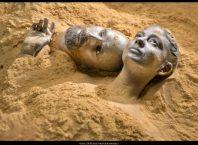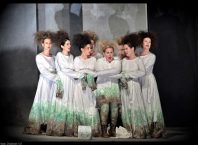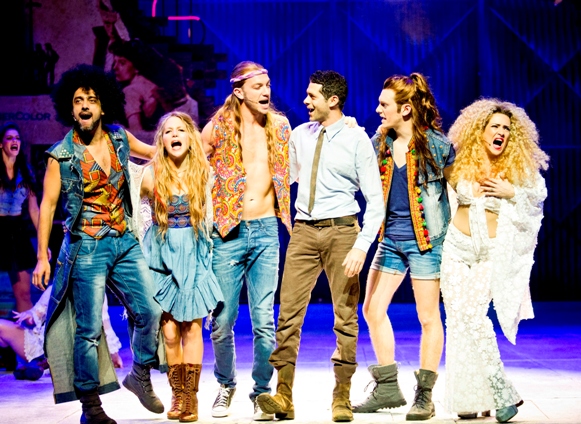
Let me rave about the Cameri Theatre production of Hair, because director Moshe Kepten really got it right.
Originally created in the 60s by Gerome Ragni and James Rado, Hair broke with conventions, shocked and provoked audiences, but most of all, Hair captured the feel of a generation. It was never so much a plot-driven or character-driven work, as one that not only described but created an experience. It was as much a happening as a show. Writer James Rado is quoted in Patrick Pacheco’s LA Times article (June 17, 2001): “We had this idea of bringing the intense theatricality and life that we saw on the streets in New York into the theater. There was all this potential drama going on out there, and Gerry and I wanted to capture that.”
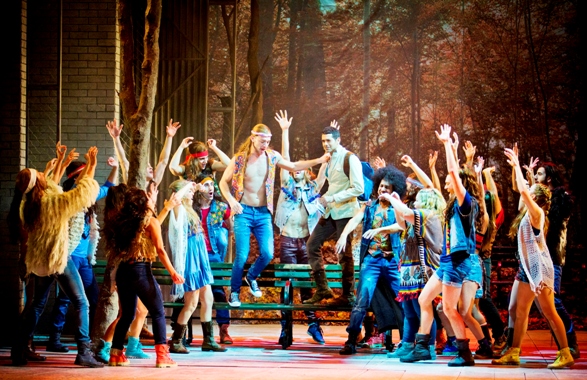
Creating that experience for the audience is the essence of Hair, and it relies on the Ragni/Rado/MacDermot songs and their performance. The soloists must be excellent – and they are, but in this show, the tribe is as crucial as the leads. The tribe is charged with the task of creating that “peace, love, freedom, happiness” vibe – and they do. Like the corps de ballet, the chorus rarely receives the kind of attention merited by the leads and soloists. Yet the impact of Hair would not be possible were it not for the entire cast’s ability to perform numbers that go beyond a song and dance, to generate the feel of a mass movement, an overwhelming sensation.
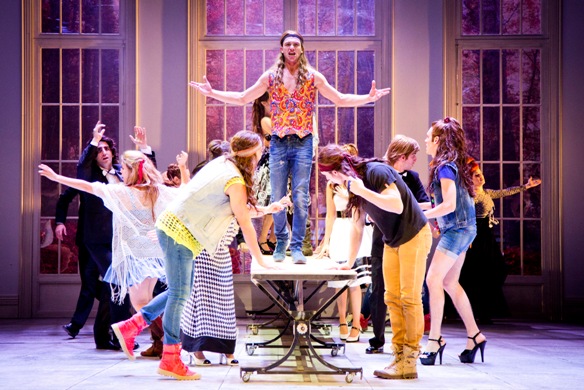
Hair has always worked on two, seemingly contradictory central themes: on one hand, it’s a feel-good rock fest, and on the other, it’s a serious anti-war statement. The original version did not have that much of a plot, which successive version have altered here and there to make a more coherent narrative. Yet it remains a show centered on the flow of one pop-rock song after another, beautiful bodies in colorful costumes, sexy energy and youthful exuberance. How does that connect to the anti-war movement? Far be it from me to glorify the 60s, the hippies or the flower children, and indeed, Hair does not attempt to present these young people as anything other than fairly self-obsessed, often confused drifters looking for a good time. Yet I don’t see this as contradictory to a forceful anti-war statement – on the contrary. The tribe is very much about feeling good in the moment, and feeling good, for all its drawbacks and qualifications I might add (such as consideration for others, watch for Chen Amsalem’s rendition of “Easy to be Hard”), is, in this writer’s opinion, a far better purpose in life than killing people as a mode of conflict resolution. Kepten makes the anti-war theme very explicit from the start, employing a variety of artistic means to convey the message. This not only contributes to the thematic coherence of what in its original version was a rather diffuse narrative, but also offers a strong response to those who might question the relevance of Hair to contemporary audiences.
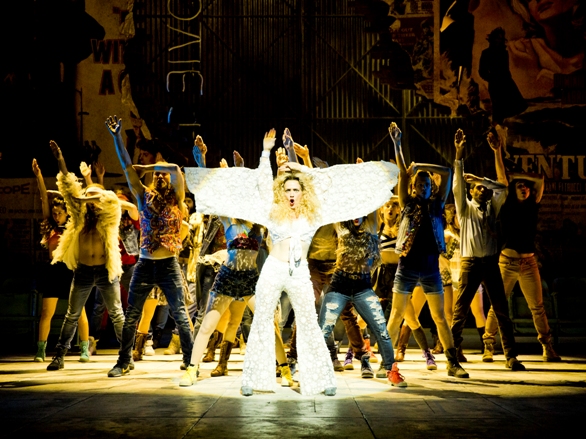
The music and movement make this show, and the burden of proof that weighs heavily on any revival of a classic is even heavier here, when the songs are performed in Hebrew. I was much too young for anyone to remotely consider taking me to see Hair in its first incarnation, and much to precocious to be unaware of the show and its radical potential. As soon as I was old enough, I purchased the vinyl, and I have known these songs by heart since I was ten. In other words, when it comes to watching Hair in Hebrew: I am a tough customer. The Israeli cast is fantastic! It doesn’t matter that they are singing in Hebrew because they are conveying something that goes beyond language, beyond words. And they do it so well! There is a talented musical team here, under the musical direction of Yonatan Goldstein and Tal Blecharovitz, and the outcome is simply wonderful! The choreography is tricky here too, because it’s success is measured by how natural and spontaneous it feels, while at the same time meticulously conceived and performed. Bravo to choreographer Avichay Hacham and all those super-charged dancers!

Some of the strongest elements in creating a mood are those that work on us without our ever being aware of them (except that as a critic, one sits in the audience hyper-alert for those elements), in this show, the set design is a star! The concept, art and execution were always visually enticing, and worked to create an undercurrent of associations! The set was framed by television screens, recalling that Vietnam was the first war that people watched in their living rooms, providing a space for ongoing visual commentary and emphasis. The movie theatre with the giant Antonioni and James Dean posters, the blues skies and orange-crimson leaves of fall in New York, the jail and more… Scene changes took place so smoothly, it was all part of the flow and made me want to stand up and cheer for everyone involved in making and manipulating this set!
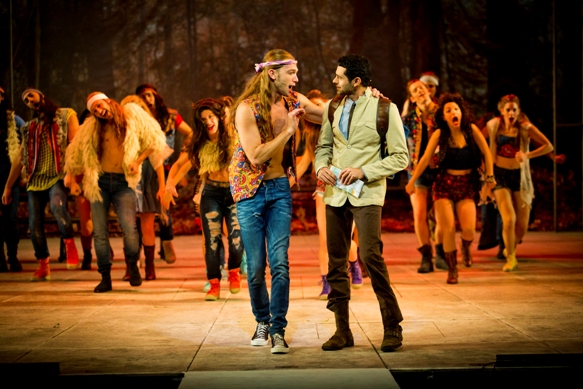
The cast is excellent! Oz Zehavi is a very charismatic Berger, no wonder everyone in the tribe loves him! Dan Shapira is perfect as Claude, conveying the confusion of a young man torn between fidelity to all he has been brought up to believe, and the temptation of being true to his feelings. His rendition of “Where Do I Go?” is touching and as true in 2015 as it was in 1968, we are all still searching. Meshi Kleinstein sang a very warm and sweet Frank Mills, which is a difficult song of naive and immature lost not-quite-love that can so easily go wrong in performance. Mei Finegold was has the voice and presence to carry Dionne to those theatrical heights that the 60s demand. Danny Leshman’s Woof is delightfully ambiguous, not only attracted but attractive to both women and men, and Meyrav Feldman’s Jeanie so bouncy and endearing.
As I watched the show this past Friday, I marked each peak moment with a star, and by the show’s end, I had a notebook full of stars. Let the sun shine.
Hair
Book and lyrics by Gerome Ragni and James Rado; Music by Galt MacDermot; Originally produced on the New York Stage by Michael Butler; Translated by Ehud Manor; Directed by Moshe Kepten; Choreography by Avichay Hacham; Music direction: Yonatan Goldstein, Tal Blecharovitz; Set design: Eran Atzmon; Costumes: Yuval Kaspin; Lighting: Keren Granek; Cast: Oz Zehavi (Berger), Dan Shapira (Claude), Ofir Zemach (Hud), Danny Leshman/Ido Rozenberg (Woof), Meyrav Feldman (Jeanie), Chen Amsalem (Sheila), Mei Finegold (Dionne), Chrissy (Meshi Kleinstein).

